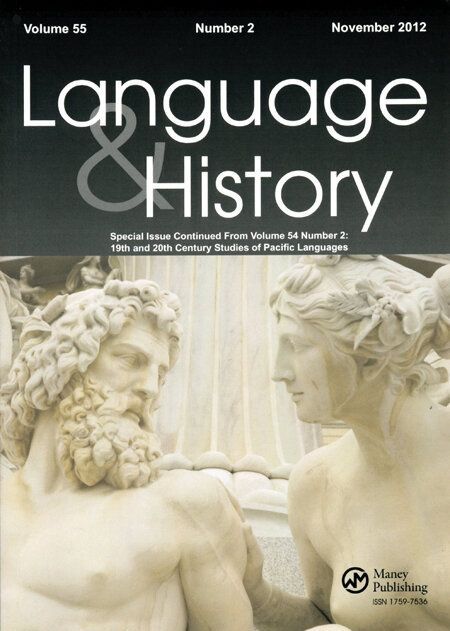Introduction benjamins.com/catalog/dia....
The introduction to our tone special (double) issue is now online!
Diachronica journal
@diachronica.bsky.social
The official account of the journal Diachronica
@diachronica.bsky.social
The official account of the journal Diachronica
Introduction benjamins.com/catalog/dia....
The introduction to our tone special (double) issue is now online!
The diachronic evolution of syllable-onset /Cl/ clusters in Romance revisited benjamins.com/catalog/dia....
22.10.2025 18:09 — 👍 0 🔁 0 💬 0 📌 0Kra-Dai tonogenesis in Austro-Tai perspective benjamins.com/catalog/dia....
22.10.2025 18:09 — 👍 0 🔁 0 💬 0 📌 0I am so grateful to the editors of Diachronica for letting me write this piece in memoriam of Bill Labov.
And so grateful that they let me write what I most wanted to - a piece about Bill's *goodness*, his love for humanity, and how those things *resulted in* what we think of as his genius
🐦
New publication on Dinka by NILOMORPH member Mirella Blum - "Dialectal tone description enhances historical tonology", in @diachronica.bsky.social
www.jbe-platform.com/content/jour...
Falling in love with humanity benjamins.com/catalog/dia....
08.09.2025 13:06 — 👍 2 🔁 1 💬 0 📌 0Multiple source explanation in language change benjamins.com/catalog/dia....
08.09.2025 13:06 — 👍 1 🔁 1 💬 0 📌 0The history of the [ɨm] causatives in Mapudungun benjamins.com/catalog/dia....
08.09.2025 13:06 — 👍 3 🔁 0 💬 0 📌 0The history of the [ɨm] causatives in Mapudungun benjamins.com/catalog/dia....
08.09.2025 13:05 — 👍 0 🔁 0 💬 0 📌 0www.jbe-platform.com/content/jour... is now out, @betsysneller.bsky.social 's beautiful tribute to Bill Labov
08.09.2025 13:03 — 👍 6 🔁 4 💬 0 📌 1Diachronica benjamins.com/catalog/dia....
Benjamins now has a "share on bluesky" button (along with Facebook and LinkedIn)

Método comparativo para la determinación de préstamos de lenguas indígenas no habladas en el español El caso de los cognados en el muysca ORCID logoDiana Andrea Giraldo Gallego | Universidad de Antioquia El muysca pertenece a la familia lingüística chibcha y aunque se clasifica como una lengua no hablada, préstamos léxicos con su origen sobreviven en el español de Colombia. Aquí se muestran algunos de estos que se identificaron como tales al implementar el método comparativo. Los préstamos determinados bajo este método se tomaron de Giraldo Gallego (2015). Se concluye que (a) el método comparativo es útil para determinar préstamos de lenguas indígenas no habladas en el español, como ocurre con el muysca; (b) la comparación con lenguas no habladas favorece la propuesta de cognados de lenguas habladas, como acontece con el tunebo; (c) la propuesta de cognados permite la identificación de rasgos fonéticos-fonológicos, como en el caso de un posible segmento lateral alveolar aproximante para el muysca (Giraldo Gallego 2016a); y, además, (d) ayuda en la reconstrucción de étimos en una protolengua como se evidencia con el protochibcha. Keywords: cognado, familia lingüística chibcha, muysca, préstamo léxico, protochibcha
Método comparativo para la determinación de préstamos de lenguas indígenas no habladas en el español benjamins.com/catalog/dia....
23.08.2025 12:55 — 👍 1 🔁 0 💬 0 📌 0
A long farewell What the loss of V2 made briefly visible ORCID logoCecilia Poletto | Goethe Universität Frankfurt am Main | Università degli studi di Padova ORCID logoPierre Larrivée | Université de Caen Normandie ORCID logoFrancesco Pinzin | Goethe Universität Frankfurt am Main ORCID logoMathieu Goux | Université de Caen Normandie The verb second word order (V2) is known to have been present in some Medieval Romance languages, and to have been lost. The loss is however a gradual process that we propose to relate to the decreasing height of the verb movement in the left periphery through the Medieval period: whereas in the initial period the verb could move to a high position (CP Topic/Focus projection), in the final period only lower peripheral positions are accessible. This means that the ongoing change will make visible constructions involving verb movement to a lower position. Such constructions are studied here in parallel texts calibrated for provenance and text type from two Romance languages for the period from the beginning of the 14th century to the 16th century. More specifically, we investigate Participle and Infinitive Fronting in French and Venetian, showing that these structures involve low movement and correlate with a V2 of the low type. Keywords: verb second, language change, fronting, Medieval Romance, French,
A long farewell benjamins.com/catalog/dia....
23.08.2025 12:54 — 👍 3 🔁 1 💬 0 📌 0
Emergence and evolution of free variation in Central Pame prefixes Sound change vs. paradigmatic structure ORCID logoBorja Herce | University of Zurich Many word forms from different classes in Central Pame (cent2145, Otomanguean) allow two synonymous forms, one containing a prefix with the vowel /a/ and another one with /u/ (e.g. wa-ttsáuʔ~wu-ttsáuʔ ‘(s)he feels’). I conduct historical corpus research and elicitation to throw light on the diachronic origin and contemporary profile of this unusual phenomenon. Evidence suggests that it started as a sound change /a/ > /u/ between bilabial consonants. However, paradigmatic pressures have largely dismantled the original distribution of allomorphy synchronically, generalizing free variation (i.e. overabundance). In addition, other phonological and morphosyntactic cues have emerged for the probabilistic prediction of these allomorphies. The case provides an extraordinary window into the cognitive underpinnings of sound change, allomorphy, and the paradigm in a highly-inflecting and understudied language. Keywords: paradigm, sound change, overabundance, analogy, Otomanguean, Central Pame
Emergence and evolution of free variation in Central Pame prefixes benjamins.com/catalog/dia....
23.08.2025 12:53 — 👍 3 🔁 1 💬 0 📌 0
In this paper, I provide a first systematic analysis of grammatical tone (GT) in the verb phrase of northwestern (NW) Bantu languages. Based on a sample of twelve languages, I show that GT on preverbal subject agreement, tense, aspect, mood, and polarity markers, on the verb stem, and tonal phrase-medial/phrase-final verb distinctions are inherited features. In contrast, GT on elements immediately following the verb is an innovation in some genealogical subgroups of NW Bantu. In Proto-NW-Bantu, GT generally co-occurred with segmental morphemes. This “co-exponence” type is retained in the Proto-B clade of NW Bantu, while languages of Proto-A innovated more exponence types, namely tone-only and segment-only exponents, synchronically exhibiting all three exponence types in individual languages.
Towards reconstructing grammatical tone in the northwestern Bantu verb phrase benjamins.com/catalog/dia....
23.08.2025 12:52 — 👍 6 🔁 1 💬 0 📌 0
"If your books were uploaded to LibGen/fed into the LLMs, add your name to the potential class action lawsuit by tomorrow." Details:
LibDem database: www.theatlantic.com/technology/a...
Attorney form: www.lieffcabraser.com/anthropic-au...
(This information comes via a reliable Discord source.)
We will be at ichl next week! Happy to talk about potential submissions
15.08.2025 03:28 — 👍 3 🔁 0 💬 0 📌 0Entirely selfishly, I'm also pleased by echoes of work I've done: "Convergence in the formation of IE subgroups: Phylogeny and chronology" (2006); "Descent and diffusion in language diversification: A study of Western Numic dialectology" (with Babel, Houser & Toosarvandani, 2013).
02.08.2025 00:00 — 👍 1 🔁 1 💬 0 📌 0Sing ~ Siew ? Song ~ saw? Sung ~ sow.
01.08.2025 21:02 — 👍 1 🔁 0 💬 0 📌 0Here we are, please add us when you have a chance!
01.08.2025 17:06 — 👍 1 🔁 0 💬 1 📌 0
Accent and tone The double origin of the Paicî prosodic system ORCID logoFlorian Lionnet | Princeton University What happens when an accentual language develops a tonal contrast from laryngeal features: is the accent system kept alongside the new tone contrast? Is it lost? Do both prosodic systems merge? In this paper, I present the tone system of Paicî, which illustrates the latter outcome. Paicî seems to possess two integrated prosodic subsystems: a purely tonal H vs. L contrast, and a typologically unusual downstep with accentual properties. Building on Rivierre (1978), I show that a comparison with neighboring Xârâcùù, where accent is marked by a similar downstep, explains this apparently mixed system: the H/L tonal contrast emerged through tonogenesis in an already accentual language, where accent was marked by a downstep just like in Xârâcùù. This caused the former downstep to be reinterpreted as tonal. The Paicî case is interesting for the study of the interactions between accent and tone, both in synchrony and in diachrony. Keywords: tone, accent, downstep, Paicî, Xârâcùù, Oceanic, New Caledonia
New article in the tone special issue
#linguistics
benjamins.com/catalog/dia....
Accent and tone
The double origin of the Paicî prosodic system
Florian Lionnet | Princeton University

Tonogenesis A diachronic typology ORCID logoLilja Maria Sæbø | Oxford University ORCID logoEitan Grossman | The Hebrew University of Jerusalem ORCID logoSteven Moran | University of Neuchâtel | University of Zurich This article presents the Database of Tonogenetic Events (DTE), which describes 259 tonogenetic events from 104 genealogically and geographically diverse language varieties. The DTE allows us to identify the main types of reported tonogenesis triggering contexts, the types of resultant tones, and their effects on pitch. We illustrate the usefulness of the database with case studies addressing (i) the frequency of different types of tonogenesis, (ii) the diachronic pathways linking phonological triggering context and resultant tone, and (iii) areal trends. We also discuss the shortcomings of the database with respect to the diachronic typological study of tone. Keywords: tonogenesis, typology, tone, historical linguistics
New article in our tone special issue
#linguistics
benjamins.com/catalog/dia....
Tonogenesis
A diachronic typology
Lilja Maria Sæbø | Oxford University
Eitan Grossman | The Hebrew University of Jerusalem
Steven Moran | University of Neuchâtel | University of Zurich

Urban dictionary definition of wireback: A slang term used to mock robots or AI, poking fun at their reliance on messy wires and artificial support, like a half-baked machine acting clever. "That wireback botched it, guess the tin trash can’t keep up with the humans again!"
Another reason humans are infinitely better than "AI": it can't keep up with language change. Urban Dictionary bests Gemini every time!
Gemini's definition of wireback:
The term "wireback" is not a recognized or established slang term. It's likely a misspelling or a misunderstanding of other terms

Are you working on topics related to the history of linguistics?🫵
Consider submitting an article to ✨Language & History✨, the journal of the Henry Sweet Society! It is an interdisciplinary, peer-reviewed journal published 3 times per year both online and in print.
www.henrysweet.org/language-and...
So glad this is out! Still wish we had the data processed in time for @jmhenner.bsky.social to use but pleased to have his contribution in more ways than 1. See below for a brief commentary re Jon, deaf linguists & participating in SiL research and doing it in a way that disrupts or crips it all
31.07.2025 19:44 — 👍 26 🔁 9 💬 2 📌 0
Late Malayo-Polynesian A new model of Austronesian linguistic relations ORCID logoAlexander D. Smith | Fudan University Models of higher-order Austronesian linguistic relations have traditionally involved the grouping of languages into large higher-order subgroups. In the Malayo-Polynesian subgroup, that tradition has led to the creation of subgroups covering great geographical distances all modeled as descending directly from the Malayo-Polynesian node. This research argues that the evidence for those large subgroups does not stand under scrutiny. Rather, the distribution of innovations throughout the Malayo-Polynesian region suggests that those innovations spread within a large network of dialects. That network, here dubbed the “Late-Malayo-Polynesian” network, replaces discrete higher-level nodes in the classical model of Austronesian linguistic relations. Keywords: Malayo-Polynesian, Austronesian, subgrouping, linkages, language contact
New #linguistics article!
Late Malayo-Polynesian
A new model of Austronesian linguistic relations
Alexander D. Smith | Fudan University
benjamins.com/catalog/dia....
Keywords: Malayo-Polynesian, Austronesian, subgrouping, linkages, language contact
Huge week for Sumerian culture:
23.07.2025 20:24 — 👍 42 🔁 11 💬 0 📌 1
Learning to be (un)hip in panel data Exploring quotative be like across the adult life‑span ORCID logoAnne-Marie Moelders | Sociolinguistics Lab, University of Duisburg-Essen ORCID logoIsabelle Buchstaller | Sociolinguistics Lab, University of Duisburg-Essen The quotative system is a highly dynamic domain characterised by competing traditional variants (say, think) and newcomers (be all, be like) (Buchstaller 2013). Trend and apparent time studies have focused on be like, describing its expansion across the English-speaking world and reporting incrementation amongst the younger age-brackets (D’Arcy & Tagliamonte 2003; Gardner et al. 2021). “Information on speakers’ loyalty to be like across their lifespan is conflicting”, however (Buchstaller 2015: 460). We report on a dynamic panel corpus to assess malleability in the quotative system across the adult lifespan. Our findings suggest that the grammar underlying be like remains largely stable across the lifespan. And while most socio-demographic factors do not significantly influence speakers’ quotative choices, we seem to witness the development of socially niched retrenchment in the middle age brackets, turning one of the most vibrant changes in the English language into a gender-differentiated and age-graded pattern. Keywords: quotation, language change across the lifespan, panel research
New paper! #linguistics
benjamins.com/catalog/dia....
Learning to be (un)hip in panel data
Exploring quotative be like across the adult life‑span
Anne-Marie Moelders, Isabelle Buchstaller | Sociolinguistics Lab, University of Duisburg-Essen

Tonogenesis in the Naduhup family of northwest Amazonia ORCID logoMark Simmons | University of California San Diego ORCID logoPatience Epps | University of Texas at Austin While tone is widely encountered among Amazonian languages, Amazonia has generally been underrepresented in wider studies of tone and tonal diachrony. This paper offers a case study of tonogenesis within the small Naduhup language family of western Amazonia. We propose that Naduhup tonogenesis was grounded in a prior contrast involving vowel length and was linked to coda voicing. Contact with neighboring languages in which tone was already present was also a likely catalyst. In addition to contributing to our understanding of tonogenesis in a part of the world where these processes are not well known, the Naduhup case provides an illustration of how vowel length, coda voicing, and intonation may all play a role in the emergence of tone.
New paper! #linguistics
Tonogenesis in the Naduhup family of northwest Amazonia
Mark Simmons | University of California San Diego
Patience Epps | University of Texas at Austin